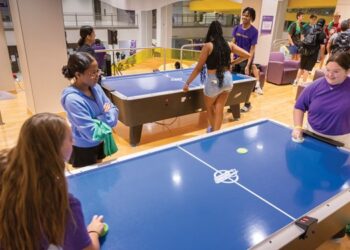After the Boston Marathon Bombing, a lab on the Massachusetts Institute of Technology’s (MIT) campus began to develop prosthesis for several of the survivors. But, the university’s impact on this specific community didn’t stop there. “We opened up our pool to be a bit of a living, learning laboratory so that some of those amputees could test the prosthesis within our aquatic facility,” said Tim Mertz, the director of MIT recreational sports.
The Boston Marathon Bombing amputees are just one of many examples when it comes to handicap accessibility in MIT’s aquatic center. As something that is constantly changing in terms of regulations and laws, the core of handicap accessibility remains the same: it is the ability to allow the public equal access, said Benjamin McElhiney, the director of aquatics at MIT.
For starters, this means being compliant with the standards set by the Americans with Disabilities Act. Joe Wakeley, the assistant director of campus recreation at Ohio University, explained the aquatic facility recently went through a renovation that added two new locker rooms — family and gender neutral — with handicap accessible spaces. The facility also has a portable and stationary chair lift and a low-rise staircase that goes into the water.
A unique feature at MIT is that its pool was built with a 14-inch draft. Since the standard maximum height of most pools is a 12-inch draft, McElhiney said they had to have a lift custom made. Reaching out to various companies, Aqua Creek Products agreed to take on the project.
However, just meeting the ADA’s minimum standards is not where MIT nor Ohio University stopped. “There are those nuts and bolts, from the lifts to the doorways to the ramps, and all great facilities have to meet those minimum ADA standards, but I think when you then infuse staff, programming, expertise and maybe regional locale, you can really create some open and inclusive programs for that community,” said Mertz.

Wakeley explained that he is heavily involved in his local community, allowing him to connect with various voices throughout the area. He explained asking questions of current and potential patrons could often lead to comments he might not otherwise have heard. “You start out with the law — what’s required. Then you start looking around and you start talking to people that may have put something in,” he said. “We’re here to serve people and at the end of the day, if people aren’t talking to us about what they need, it gets really difficult to figure out how to meet that need.”
For example, Wakeley worked with a gentleman who had struggled with MS. When Wakeley asked him if he liked the chair lifts with the sling seats, the man replied, “Not in the least.” By talking with the community and making the changes, Wakeley has opened the door wider for people to come in and share their needs with him. “My biggest advice is: keep asking questions,” he said. “Mostly, ‘why?’ And if you’re not asking why, ‘why not?’ should be asked.”
On top of talking to the community, McElhiney said utilizing people across campus is also beneficial to handicap accessibility. Students, faculty and the campus planning office will share ideas on how to increase equal access in not only the aquatic center, but from one end of campus to the other.
Even though handicap accessibility is constantly changing, it is necessary to focus on to ensure that everyone can pursue a life of fitness. “Much of what we do is try to encourage people to stay healthy, to be active and to commit to fitness,” said Mertz. “When you create a facility that accommodates those that have mobility issues, and you can prove that even they are making that commitment to health and wellness, it inspires everybody else.”










